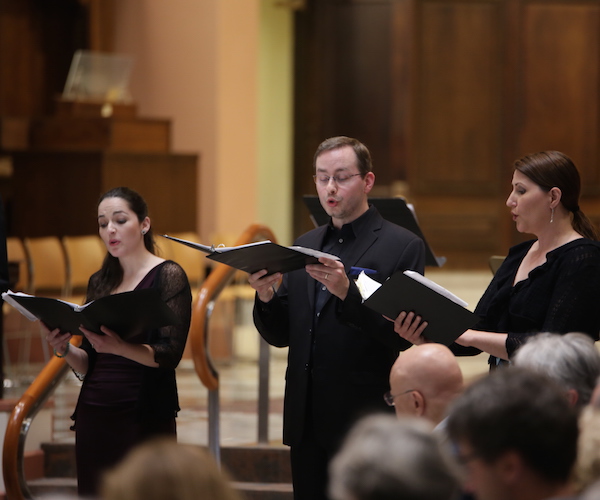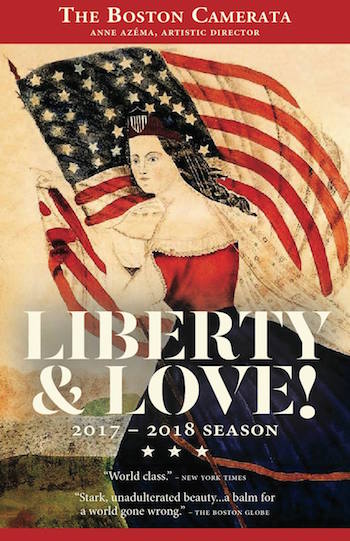Music Preview: Boston Camerata’s “Liberty Tree”
There’s a remarkable breadth and depth, both textural and musical, to this collection of songs and dances that date back to the earliest years of the Republic.

Boston Camerata in action. Photo: Ohkyeong Kwon
By Jonathan Blumhofer
Say what you will about the willingness of the arts (particularly classical music) to readily engage with the conflicts and conundrums of everyday life. Boston Camerata’s season-opening Liberty Tree (October 29 at 4 p.m. at the Harvard Memorial Church, One Harvard Yard, Cambridge) doesn’t shy away from difficult questions or themes: it looks to tackle patriotism, race, religion, and several other topics, all through the experience and views of 18th– and 19th-century American composers and authors. A survey of early-American songs and anthems by a wide range of figures, some (like William Billings and Jeremiah Ingalls) familiar, some less so, it’s a program that, in the words of the Camerata’s artistic director Anne Azéma, allows us to look “backwards to make sense of the present and reassure ourselves of our future.”
“Last year, when we opened our season, we opened with a political program called City of Fools,” Azéma explained in an interview. “And I’m more and more aware of the world that I live in. My connection with American music started a long time ago. And I think it’s a proper age to propose a reflection on the young republic and on potent ideas about tyranny, about liberty, freedom, and how one finds one’s place in the city and in America in particular. Because I thought that these reflections that were the reality of the 1790s to 1840s may still be relevant today and that we might find food for thought.”
Indeed, to look at the Camerata’s program, which is divided into a series of “chapters” (“Boston is a Yankee Town,” “Friendly Union,” etc.), is to be struck, first, by the timeliness of the repertoire. Beyond that, there’s a remarkable breadth and depth, both textural and musical, to this collection of songs and dances that date back to the earliest years of the Republic. Which of them speaks most strongly to our present historical moment? Several, Azéma says.
“I think the text by Thomas Paine on ‘Liberty Tree’ is a very potent one,” she begins. “It presents Liberty as a goddess – ‘In a chariot of light from the regions of day,/The Goddess of Liberty came;/Ten thousand celestials directed the way/And hither conducted the dame’ and ‘The celestial exotic struck deep in the ground/Like a native it flourished and bore;/The fame of its fruit drew the nations around,/To seek out this peaceable shore.’ That plan that the goddess of Liberty gives to people is very potent and allows them to sit down and discuss. And, to me, that’s a very powerful text.”
“’O Zion Rise’ is a Shaker anthem,” Azéma continues. “And, even though [the Shakers] were a religious community, they were very much anchored in the world. ‘O Zion’ is a very powerful piece. Zion is, of course, the city on the hill, and this text sets up a vision where all kindreds, all colors, all nations, all peoples – no nation or sect is rejected at all. So, it’s this utopian place that we all aim towards.”
At the core of the Camerata’s program is a strong emphasis on the subject of equality.
“‘The Rich Man,’ by Jeremiah Ingalls,” Azéma notes, “reminds us that everybody should be included. And, even if you’re rich, if you don’t give to the poor at your door, you will be rejected. That this community can’t be founded with people being rejected.”
That includes racial minorities. “We have a whole chapter around the African-American experience,” she continues, “and I find that ‘The Rich Man,’ even if it doesn’t speak directly to that experience, relates with the idea that all kindred, all people must be included.”
And it’s a theme that’s reinforced across chapters: “‘Rights of Conscience,’ another Shaker anthem, is beautiful. Again, if not everybody is free to join, how can we pretend that we have a republic, that we have a community? And I think that of ‘Friendly Union,’ from John Peasy, which was found in a collection of spiritual songs from Portsmouth, NH: why can’t we all be under the same roof and actually have a peaceful conversation?”
“So,” Azéma concludes, “all of our [contemporary] worries are addressed by these powerful anthems and pieces.”
As for how audiences should respond to this old music speaking to our present situation, Azéma sees a number of interesting, cross-century connections. “If you follow this music,” she says, “what’s immensely moving to me as a professional musician is that we’re at the crossroads of so many worlds: of the world of people who build a community and use music as a community builder. We’re at a crossroad of high art and music done by amateurs for amateurs. You know, William Billings was a tanner, not formed by conservatory training. And yet his ‘David’s Lamentation’ is immensely powerful and moving. And Ingalls, a tavern-keeper from Vermont, with all this beautiful folk hymnody, brings another flower to the bouquet. And all these other people reflecting on their place in a young republic with the help of Paine and others, you constantly have this cross-world.
“The way we are today is a case in point. Sometimes we may have this idealized vision of the past: all clean, a Hallmark image of what the past might have been. But the past was a struggling moment when people had to face what they could become as a community, as a country, as New Columbia, and it must have been just as difficult as it is now. But there were some very powerful community builders via music and I think this points to the fact that we’re not finished, number one, and that art and music is a way to help us bind all these things together.”

Ultimately, Liberty Tree endeavors to articulate certain foundational American principles. And it serves as a summons to stay the course: “We all have an elementary vision of what America is,” Azéma says. “Despite all these debates, we are open, we have an ideal of what this City on a Hill is, and all who can come are invited, regardless of all the differences we might have.”
The rest of the ensemble’s season is, perhaps, a bit less political in tone. There are a pair of Christmas programs (Mediterranean and French) in December, plus a reprise of Camerata’s acclaimed Tristan & Iseult (at Pickman Hall in April) to anticipate. Still, Liberty Tree ranks high on Azéma’s personal list: “I think that Liberty Tree, for me, is the highlight of the season, because of the power of the music…because it’s directly connected to Boston in so many ways.”
Even more than that, Liberty Tree addresses some of the fundamental reasons the Camerata performs the repertoire it does. “You know,” Azéma explains, “we say we do early music but what does it mean to do early music? We’re in 2017 and so we can make all the well-informed choices we can: we can be good students and scholars and know every single that can be known, and discuss and do research with academics, but, in the end we’re performers and we dwell here in Boston in 2017. So the choices we make today are different than the choices made by the generation before and, hopefully, by the generation after. And what’s becoming more and more interesting to me is how do we describe our musician-selves and our citizen-selves in the course of all that? What does it all mean to be a musician, to be a performer, to do this musician in the context of everyday life?”
Liberty Tree seeks to provide answers to these questions, and more.
Jonathan Blumhofer is a composer and violist who has been active in the greater Boston area since 2004. His music has received numerous awards and been performed by various ensembles, including the American Composers Orchestra, Kiev Philharmonic, Camerata Chicago, Xanthos Ensemble, and Juventas New Music Group. Since receiving his doctorate from Boston University in 2010, Jon has taught at Clark University, Worcester Polytechnic Institute, and online for the University of Phoenix, in addition to writing music criticism for the Worcester Telegram & Gazette.
